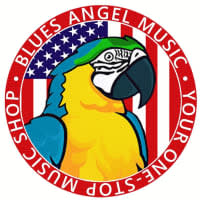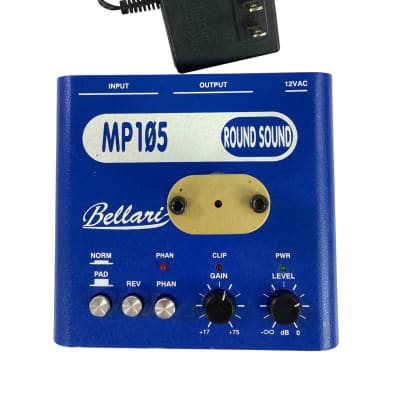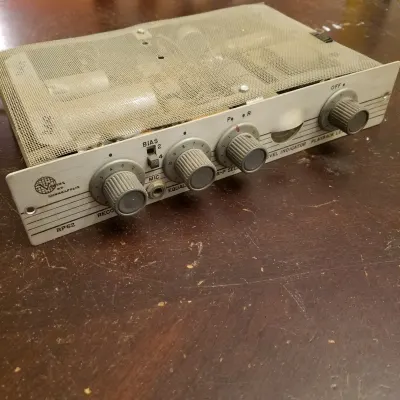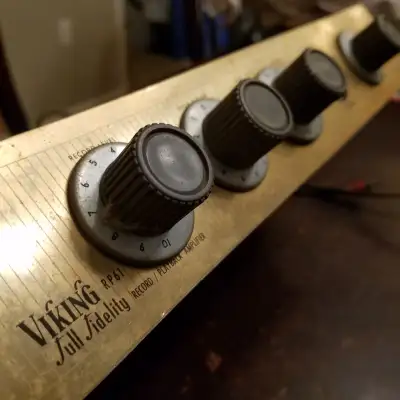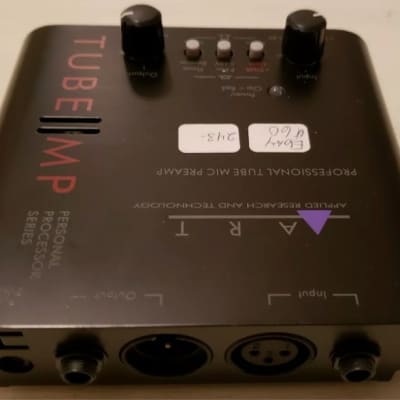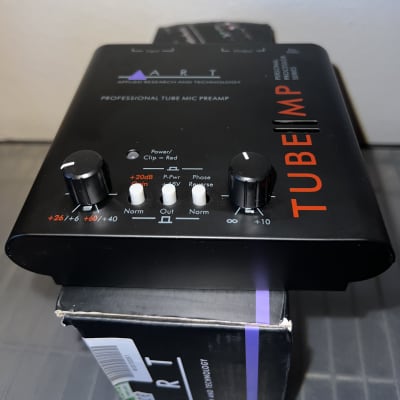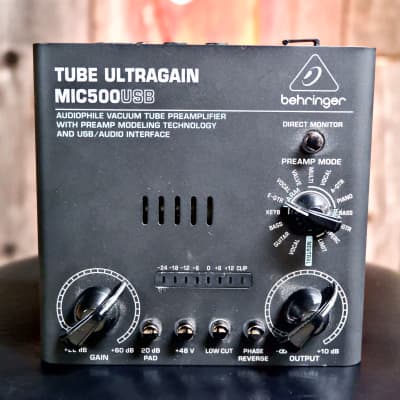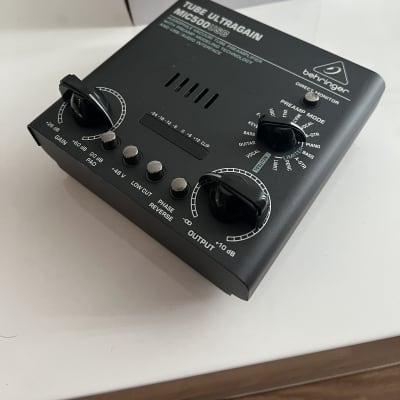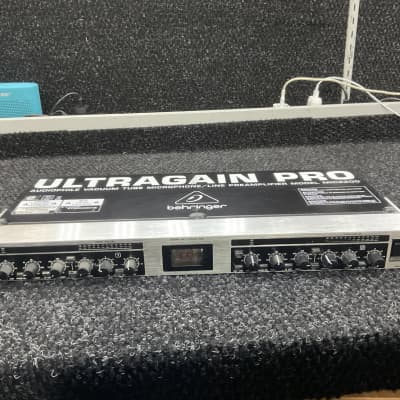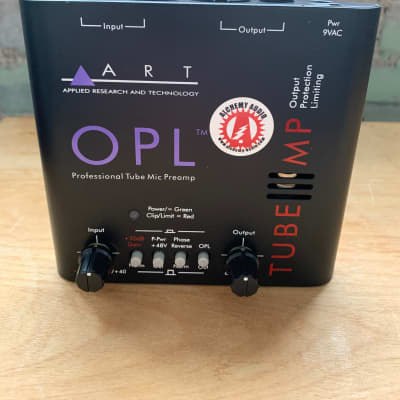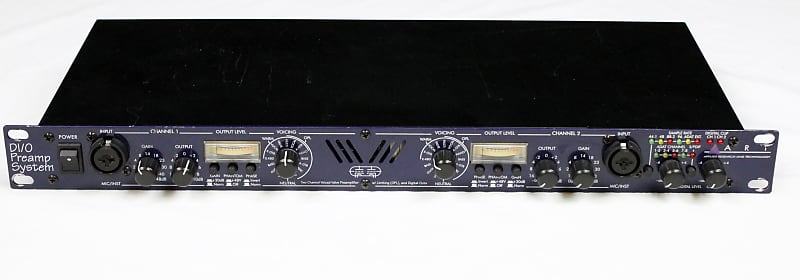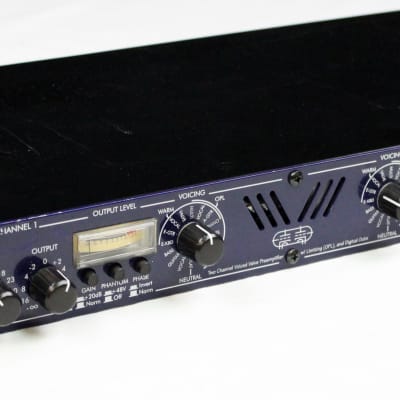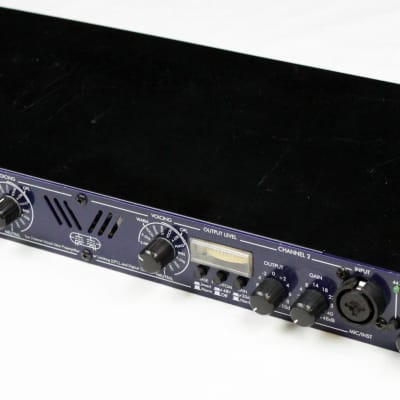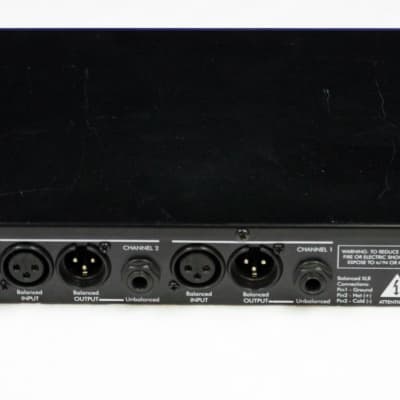Thank you for taking the time to visit Blues Angel Music's Reverb store! Blues Angel Music, est. in 1997 in Pensacola, Florida, has been named by NAMM (National Association of Music Merchants) as one of the "TOP 100" music stores in the USA since 2011!!! Your satisfaction is our #1 objective!
A.R.T. DI/O Tube Mic Preamp System , Used, #02001451
*Please read shipping information at the bottom of the listing*
Today we're pleased to offer for sale the A.R.T. DI/O Preamp System. This unit has been previously owned and has some cosmetic imperfections, but it has been thoroughly tested and functions 100% as designed. Please take a look at the photos and description and please message us with any questions that you may have about this item!
ART DPS mic preamp/ADC
The A.R.T. DPS (DI/O Preamp System) dual-channel, tube-hybrid mic preamp/A/D converter features Variable Valve Voicing ("V3"), which lets you choose the amount of tube saturation and the EQ profile via 15 presets.
In this age of soaring technology and plummeting costs, the recording engineer's dollar is stretching further and further. Products coming out today are making us slap our foreheads for spending twice the money on similar devices last year.
With the new DPS (DI/O Preamp System), ART has managed to render two of its own products nearly obsolete by combining them into one unit. A marriage of the TPS (Tube Preamp System) and the DI/O (though without the D/A conversion), the DPS costs a little more than either of those devices but considerably less than the two combined. At $319, it brings a combination stereo tube-hybrid mic preamp and A/D converter within reach of even the most budget-minded engineer.
MIRROR, MIRROR
The face of the single-rackspace DPS is a nice royal blue, and the contrast of bright-white markings makes for easy reading of the controls (see Fig. 1). As on the TPS, the analog section of the DPS's front panel is laid out in a symmetrical, mirror-image fashion, with channel 2's controls appearing in the opposite order of channel 1's. Between the two channels, six vents, arranged in a sort of V shape, permit a view of the unit's single dual-triode 12AX7A tube. The controls themselves are not reversed; the VU meters, for example, both function as you would expect, with the needles moving to the right as the signal increases. Although it's easy on the eyes, I found the DPS's layout a bit hard to get used to — I kept reaching for the wrong knobs. Every other stereo preamp I own, including ART's Dual MP, has the controls for the second channel in the same order as the first, which seems more logical to me.
From left to right on channel 1 (and right to left on channel 2), the DPS provides a combination balanced XLR/unbalanced TS input jack; two rotary knobs labeled Gain (-11 dB to +30 dB) and Output (-• to +10 dB); three button switches labeled Gain (+20 dB/Norm), Phantom (+48V/Off), and Phase (Invert/Norm); a VU meter showing output level; and a third knob, labeled Voicing, that offers varying amounts (including none) of tube saturation and peak limiting in 15 different presets optimized for different instruments (vocals, guitars, bass, and drums among them) and a 16th preset labeled Flat.
To the right of channel 2's XLR/TS input jack is the section for controlling the unit's digital amenities. It provides two rotary Digital Level (output) knobs (one for each channel; -• to +10); two red LEDs to indicate digital clipping (one for each channel); and two other rows of colored LEDs, along with a button for toggling through settings on each. The upper row, labeled Sample Rate, has six LEDs, labeled, from left to right, 44.1, 48, 88.2, 96, ADAT (which indicates that the DPS is synced to incoming ADAT clock on the ADAT input), and Ext (which indicates that the DPS is looking to the word-clock input for sync). The lower row, comprising five LEDs, shows whether the DPS is transmitting over S/PDIF or ADAT channels (actually, the S/PDIF output is always active), as well as which ADAT channels are selected (1-2, 3-4, 5-6, 7-8, or all eight at once). When none of the LEDs are lit, all digital channels are bypassed.
Though it's nice having these digital indicators and controls grouped together in one place, I prefer having output pots in the vicinity of gain controls. Also, the two Digital Clip LEDs are positioned close together directly above the Digital Level knob for channel 2, which is inconvenient — if you aren't looking directly at them when one lights up, you have no way of knowing which channel went into digital clipping.
BRINGING UP THE REAR
One of the most impressive things about the DPS is its range of I/O options. In addition to the analog input jacks on the front panel, which are easy to access even when the unit is rackmounted, the DPS's rear panel provides, for each channel, a balanced XLR input and output and an unbalanced ¼-inch TS output (see Fig. 2). Each channel also has an unbalanced ¼-inch insert jack (pre — digital fader). Digital I/O includes an S/PDIF coaxial output on an RCA jack, ADAT optical input and output on Toslink connectors, and a word-clock input on a BNC jack. Other rear-panel amenities include a standard IEC power jack, fuse access, and a legend showing XLR pin-outs.
Interestingly, though the DPS's manual maintains that the front and rear XLR jacks cannot operate simultaneously, I was able to get signal from two microphones plugged in to the two jacks at the same time. Though slightly attenuated, there was still signal from both mics. The manual does say that the ¼-inch input on the front and the XLR on the rear can both be used and that the XLR will “slightly” attenuate the ¼-inch. I found the ¼-inch input in that scenario to be extremely attenuated, however, and would agree with the manual that “this is not normally suggested.” But it's nice to know that in a pinch you can double your inputs to the DPS. Be aware that sound quality will suffer, though.
Thankfully, the rear-panel XLR balanced outs and ¼-inch TS unbalanced outs can function simultaneously without affecting one another. This is ideal if you need to route the input signal to two places at the same time — for example, to a console in through the XLR output and to an amp through the ¼-inch out.
The inclusion of both ADAT optical and S/PDIF coaxial digital outputs — simultaneously available — is one of the things that makes the price of the DPS so hard to believe. It also makes the unit especially attractive as a front end for ADATs or multitrack hard-disk recorders that provide ADAT optical as their only form of digital I/O.
o test the digital outputs, I routed them into a MOTU 2408 and recorded into Digital Performer on a G4/450 MHz. Both digital outputs worked flawlessly at 44.1 and 48 kHz, with the 2408 synced to the respective input's clock. (The MOTU sound card can't handle 88.2 or 96 kHz, so I couldn't test those sampling rates.) Note that, in addition to being able to use the S/PDIF and ADAT outputs simultaneously, both analog outputs also remain functional at all times — very handy for amp and headphone feeds.
HOOK, LINE, AND SYNC
The DPS can receive sync from one of two external means: either from an ADAT source by way of the optical input or from any device that can supply word clock over a BNC cable. This feature helped when I wanted to compare the DPS to a similarly designed but more expensive preamp-converter and I needed to get signal through both preamps into the computer at the same time. Since the 2408 can get sync only from one source, I had to have some way of getting the preamps in sync with one another.
By coming out of the optical output of the DPS and out of the S/PDIF output of the comparison preamp-converter, I was able to get both signals into Digital Performer simultaneously. Hooking up a BNC cable from the word-clock output of the comparison unit into the DPS enabled the 2408 to look at only one source to get sync.
INSERT HERE
The insert jack for each channel on the rear of the unit is a standard TRS female jack, but it is wired in reverse from most console and preamp inserts. The jack is wired for ring output (send) and tip input (return). This configuration allows you to use a regular TS cable for bringing external signals straight into the converters through the tip of the insert jack. The inserts are directly in front of the converter, which means they provide immediate access to 24-bit conversion without going through the preamp section. That makes it possible to use other preamps in tandem with the DPS's converters or to patch in line-level signals for high-quality A/D treatment. Of course, it also means that those using either an insert cable or a Ycable (with one TRS connector breaking out to two mono TS connectors) must reverse the TS plugs: the one wired to the ring of the TRS must go into the input of the outboard unit and the one wired to the tip of the TRS must go into the output — opposite from the standard insert scenario.
The tip-ring reversal also allowed me to easily compare the A/D conversion of the DPS with that of the comparison preamp-converter — I simply put a standard TRS patch cable between the insert jacks of the two preamps, thereby swapping converters, as the comparison unit's inserts are wired tip-send — ring-return. I was very impressed by the DPS's converters — they gave the sound sources (vocals, electric guitar, and electric bass) a good deal more air and presence than the other unit's converters, which in comparison sounded slightly boxy.
VOICINGS GALORE
The DPS's Variable Valve Voicing (V3), accessed using the Voicing knob on either channel, is a distinctive feature — few other tube preamps in this price range provide tonal control, much less offer customized presets. According to the engineers at ART, the different presets vary frequency response, gain, and distortion characteristics, primarily by changing the feedback loop around the tube circuit. That means each preset saturates the tube differently, has a different EQ profile, and has a different output level, which can make rapid comparison of presets a bit dicey.
Most of the settings of the Voicing knob are labeled by the instrument for which the preset is optimized (with a few exceptions such as Valve and Multi), providing a starting point for almost any recording application. Of course, the manual is wise to advise us not to stop there, but rather to give the knob a twist. After all, the A-Gtr setting could offer exactly what your vocals need to make them stand out in the mix.
In general, the four Neutral settings (Flat, Vocal, Guitar, Bass) sounded slightly dull; the four Warm settings, (EKbd, EGtr, Vocal, Valve), which are not limited, boosted the entire signal (especially the lows and high mids); and the eight OPL (Output Protection Limiter) settings, four of which are Warm (Multi, Vocal, AGtr, Piano) and four of which are Neutral (Bass, AGtr, Perc, Limit), all sounded, well, limited. From kind of squashed to super-duper squashed, the OPL settings are not great for subtle limiting, and in general I would advise careful auditioning before committing to one, especially during tracking — after all, it's practically impossible to revert to an unaffected state after recording with dynamics processing. Just the same, the OPL settings are useful for catching transients before they make it to the converters, which can save a take from digital distortion.
SHALL I COMPARE THEE?
To compare the DPS and the aforementioned preamp-converter, I first found the voicing on the DPS I liked best for a given instrument, and then I compared that sound to the same instrument recorded (with the same mic) through the comparison unit. First I tried electric guitar plugged directly in to the combo jack on the front of the DPS, with the Voicing knob set to Warm EGtr. Overall it sounded typical of a guitar plugged in to a cheap DI box — a little anemic on single-note lines and undefined and floppy on low chords. The comparison unit, which also has a ¼-inch high-impedance Instrument jack on the front panel, gave a similarly lackluster performance, though I thought the DPS sounded a bit better, providing rounder lows and a bit more high end.
On an upright bass miked with an Oktava MC012 small-diaphragm condenser, the Warm EGtr setting sounded best. Both Bass settings (OPL and Neutral) were too scooped in the high mids for my taste, making for a bass sound with far too little presence to cut sufficiently through the mix. The Warm EGtr setting gave me a smooth, warm bass tone, without the boom so common on upright bass. The comparison unit sounded much less smooth, more brittle, and muddier in the low end than the DPS.
ON LOCATION
To further test the DPS, I used it as the front end for a DAT machine in a live concert setting, using a pair of Oktava MC012s and going into the recorder from the stereo S/PDIF output of the DPS. The first group I recorded was a large ensemble of strings, winds, and voice. In OPL Limit mode, the sound on tape was actually better than that in the room — the amplified voice sounded more natural and pleasing than it had live through the P.A., and the balance of the instruments was more even.
However, on the next band, a loud jazz sextet, I could tell during soundcheck that the OPL Limit mode was compressing the cymbals and horns in unpleasant ways. After a little trial and error, I settled on the OPL Warm Multi voicing — the setting ART actually suggests for this application. The limiter caught most of the transients before they made it to the converters, but it also produced some harsh high mid resonances I hadn't heard in the room, especially in the upper range of the trumpet. Though the limiting sounded surprisingly natural and musical on the cymbals and other ultrahigh frequencies (one sign of a decent limiter, in my book), the lack of a stereo-link function meant that each channel crossed the limit threshold at a slightly different time, producing a wavering, pulsating stereo image. I therefore wouldn't recommend using the DPS's OPL settings — or any other non-stereo-linking dual-mono limiter — on loud stereo sources.
VALUE AND VERSATILITY
I am very favorably impressed by the ART DPS. Its flexible I/O and high-quality A/D conversion make it extremely useful, especially as the front end for a DAW or digital recorder. In addition, the DPS's preamps rival those found in some units costing twice as much. Given this kind of value, I can see the DPS becoming a hot item for novice and pro engineers alike. Whether you are shopping for your first outboard tube mic pre and A/D converter or just looking to add to your collection, the DPS is most worthy of your consideration.
DPS Specifications
Analog Inputs(2) combination balanced XLR/unbalanced ¼" TS (front); (2) balanced XLR (rear)Analog Outputs(2) balanced XLR; (2) unbalanced ¼" TSDigital Output(1) ADAT optical; (1) coaxial S/PDIFSynchronization(1) ADAT optical; (1) BNC word clockInserts(2) ¼" TRSPhantom Power+48V (switchable for each channel)A/D Resolution24-bitRates44.1, 48, 88.2, 96 kHz (selectable)Frequency Response5 Hz-50 kHz (±0.1 dB)Equivalent Input Noise (EIN)-129 dBA (XLR to XLR); -105 dBA (¼" to ¼")Dynamic Range>100 dBTotal Harmonic Distortion<0.01% (clean); <0.1% (warm)Tube Type12AX7A, dual triodeDimensions1U × 6.5" (D)Weight5.5 lb.
PRODUCT SUMMARY
ART
DPS
mic preamp/ADC
$319
FEATURES4.0EASE OF USE4.0AUDIO QUALITY4.0VALUE4.5
PROS: Extremely flexible I/O. Voicings offer wide tonal variety. Handsome VU metering. High-quality 24-bit A/D converters. Direct access to converters over insert jacks. External sync capability with optical Lightpipe or word clock.
CONS: No documentation on what voicings are actually doing. No dithering. Awkward placement of digital-clipping LEDs. No center detent for digital outputs. No stereo-link option for limiter.
Manufacturer
ART (Applied Research and Technology)
ALL of our guitars at Blues Angel Music are professionally detailed and set up by our very own Master Luthiers! We want your guitar to arrive in the best condition possible and ready to play! Please note that temperature and humidity changes occurring during shipping may affect setup, and the responsibility of any desired changes to setup resides with the buyer. Rest assured that most customers are satisfied with setup upon arrival!
*Shipping Information*
We use Fed Ex or USPS for our shipping services.
Expedited shipping is available for an additional cost.
"ALL" orders over $50.00 require a signature.
If you do not wish to have a signature for your item you must submit to us that you do not wish to have a signature on your item and that you assume any and all responsibility in the event your purchased item is lost during shipment or stolen from your home.
ALL shipped items include insurance
"Free Shipping" applies only to the contiguous 48 states, and not to Alaska and Hawaii.
Large Packaged Items such as Guitars, Basses, Amps, Drums, and Keyboards being shipped to Post Office Boxes will incur additional charges.
We ship most of our new items in custom-made, double-walled boxes, as many original manufacturer's shipping boxes are not strong enough to withstand multiple shipments, and have already been used at least once to ship to us. As such, your item may not come in the original manufacturer's box. We do our very best to ensure that your instrument arrives safely and securely. See our feedback for positive comments on how well we ship!
Packaging:
Our items no matter the size or shape are professionally packed by our expert shipping department. Please see our feedback for what customers say about shipped items.
If you're ever passing through Northwest Florida, be sure to stop by and say hello! We're home of the World's only full-scale Drum Set Fish Tank created by Animal Planet's hit TV show "Tanked!"
#EAM#
09.23.18
